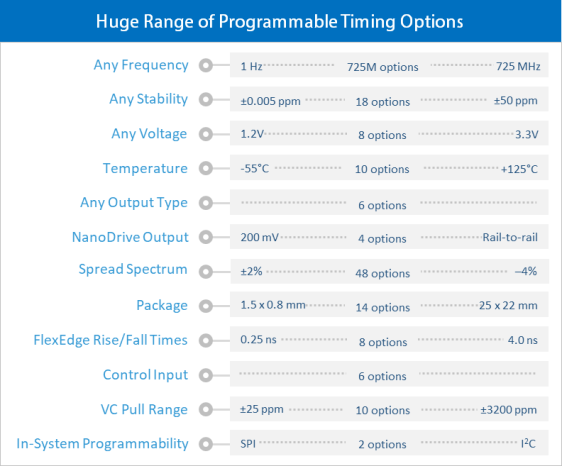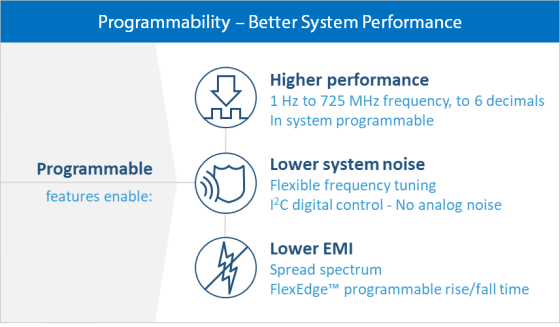Top performance-enhancing benefits of programmable timing
Oscillators have changed substantially since they were first developed in the early 1900s. When MEMS-based oscillators came on the scene in the early 2000s, the pace of innovation accelerated dramatically. One of the biggest transformations has been in the flexibility and scope of programmable timing features available, along with the resulting benefits.
What makes MEMS timing solutions so flexible? We develop complete timing systems based on a programmable architecture. And because we develop all aspects of the timing system, we’ve assembled an extremely large and flexible portfolio of programmable features that stem from our expertise in MEMS, programmable analog, and systems (packaging, algorithms).
In this blog, the first in a series on the benefits of programmable timing features, we list the top performance-related advantages that come from using a programmable timing system—one that offers very short lead times and a huge range of options (many shown in the following table).

Optimized system performance
SiTime MEMS oscillators have several programmable features that improve system performance. Here we touch on some of the options for frequency output and waveform tuning. Starting with customizable frequency, designers can optimize system performance by selecting the best output frequency for their application, which can be programmed from 1 Hz to 725 MHz, and out to 6 decimal places of accuracy. In several SiTime families, the output frequency can also be pulled from ±6.25 ppm to thousands of ppm to support integration into control loops.
Another application of programmable oscillators is dynamic frequency control. In-system programmable (ISP) oscillators can be used to boost computer performance through overclocking by slightly increasing frequency, or conversely, the frequency can be throttled back to lower system power during idle or low load conditions.
Some oscillators offer a digital interface to program and pull the output frequency. Using a digital input eliminates the introduction of system noise through sensitive analog control voltage inputs. With ISP oscillators, the frequency can be programmed from 1 MHz to 725 MHz and/or pulled up to ±3200 ppm with 5 ppt resolution and excellent pull linearity. You can learn more about the advantages of digital control in SiTime application notes, I2C/SPI Programmable Oscillators and Improved System Performance with Digital Frequency Tuning in Precision Super-TCXOs.

Programmable features can also reduce radiated clock emissions which result in EMI (electromagnetic interference). For example FlexEdge™ is a programmable feature for reducing EMI by increasing the rise and fall time of the clock waveform which decreases the drive strength. FlexEdge effectively attenuates the power of the electromagnetic waves at higher harmonics and is especially effective for mitigating EM sourced from the clock trace. Plus it has no/little impact on short term jitter such as cycle-to-cycle jitter.
Spread spectrum is another programmable EMI-reduction technique offered in SiTime’s portfolio. This method is particularly helpful in mitigating EM at the system level, reducing power peaks in the frequency domain of fundamental and harmonic components of the clock signal. Designers can use both spread spectrum clocking and FlexEdge in combination to combat EMI, lowering noise by up to 17 dB on the fundamental frequency and 30 dB on the harmonics.
These programmable noise-reducing features come with a range of options. The SiT9005 oscillator for instance has eight configurable FlexEdge settings, with slew rates from 0.25 ns to 40 ns, plus a wide spread range up to 4.0% peak-to-peak through two spread profile options: triangular or Hershey kiss. This type of flexibility is especially useful during the final stages of design when needing to pass compliance tests. Because MEMS oscillators come in several industry-standard footprints, they can used a as a drop-in replacement for quartz without any PCB layout changes, use of bulky mechanical shielding, or worse…a delay in product release.
Potent combination for Precision Timing
The frequency output and waveform tuning features mentioned above can be used in conjunction with several other programmable features that impact performance. For example, there are a range of frequency stability options available with every SiTime family. Plus, many families offer multiple supply voltage options and output formats. These programmable features can be used in any combination within the device’s broad operating range—offering unprecedented flexibility to meet the exact specification and performance needs of the system.
Come back next month to read about the programmable features that reduce size and power consumption. And in the following blog you will learn how programmable oscillators are made available with very short lead times and scalable volumes. In the meantime, check out our part number generator to see all the programmable options that spawn 100s of millions of part numbers.
………………………………………………………
Thanks to Jim Holbrook, Director of Customer Engineering, for his contributions to this article.